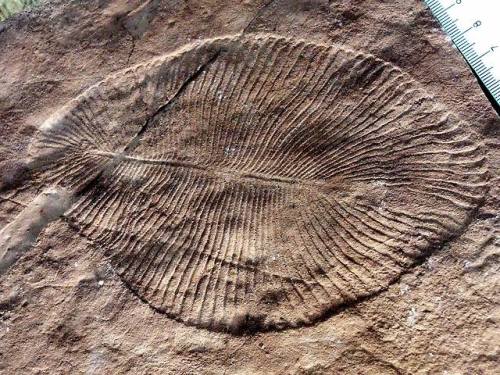Ediacaran fossilsThe biggest division in the geologic record of Earth is between the Precambrian and
Ediacaran fossilsThe biggest division in the geologic record of Earth is between the Precambrian and the Cambrian – literally everything before the Cambrian and everything after. The beginning of the Cambrian is marked by the appearance of organisms with hard parts, shells that could be preserved in the fossil record.The last time period of the Precambrian is known as the Ediacaran. It runs from about 635 to 543 million years ago, from the end of the last major “Snowball Earth” glaciation to the start of the Cambrian.Due to the start of animals with hard parts and extraordinary fossil assemblages like the Burgess shale, (http://tinyurl.com/kopvw9d), many of the body formats and evolutionary lines represented throughout the fossil record were first recognized as appearing in the Cambrian – after all, they had hard parts that could fossilize!This appearance of so many body types led to the idea of the “Cambrian Explosion”, a huge change in the types of organisms on Earth. While the appearance of hard parts definitely provoked a big change in the type of life on Earth, work on rocks from the Ediacaran has established that there was a huge diversity of life before the Cambrian explosion.This is one of the most common fossil types in the Ediacaran, Dickinsonia costata, a trace fossil of a thin organism that somehow swam along the ocean floor. The other image is an artists impression of the kind of life on the ocean floor at the time; filter-feeding, multi-cellular organisms with no hard parts that didn’t preserve well.Life definitely changed hugely when it first began forming hard shells, but the Ediacaran Ocean was a fascinating place on its own, a time when many of the body types which flourished during the Cambrian actually developed.-JBBImage credits: http://en.wikipedia.org/wiki/Ediacara_biota#mediaviewer/File:DickinsoniaCostata.jpghttp://commons.wikimedia.org/wiki/File:Life_in_the_Ediacaran_sea.jpgRead more:http://www.ucmp.berkeley.edu/vendian/ediacaran.phphttp://www.britannica.com/EBchecked/topic/179126/Ediacara-faunaA previous post on Ediacaran life:http://tinyurl.com/p5qxbpu -- source link
#ediacaran#geology#fossil#fossils#fossilfriday#research#dickinsonia costata#trace fossil

